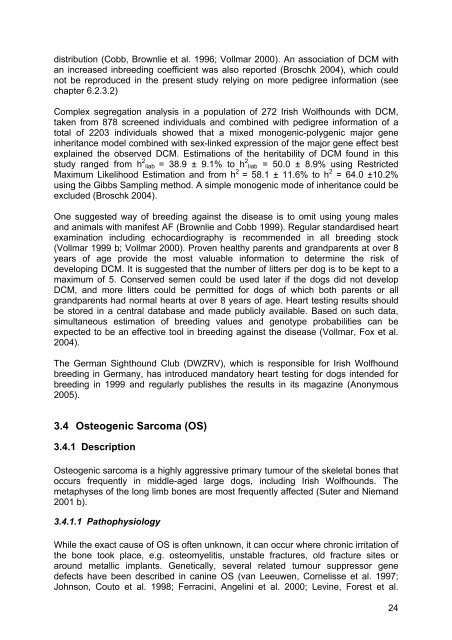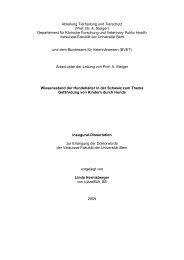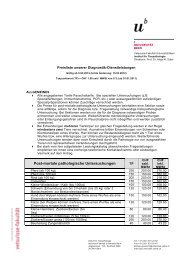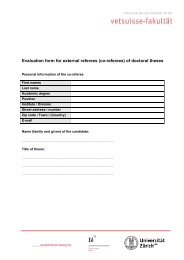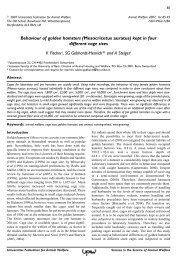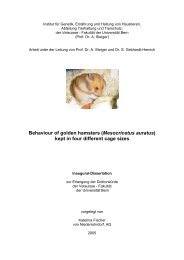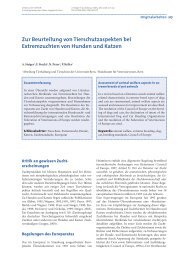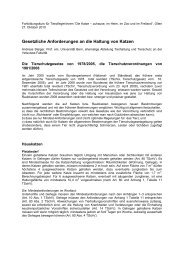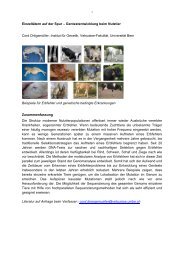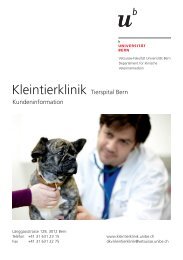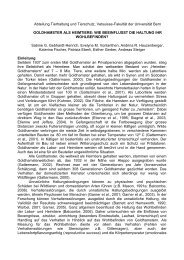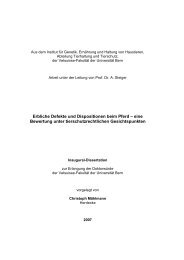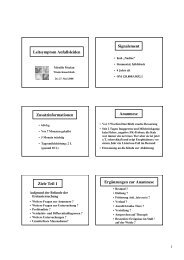Lifespan and Causes of Death in the Irish Wolfhound - Vetsuisse ...
Lifespan and Causes of Death in the Irish Wolfhound - Vetsuisse ...
Lifespan and Causes of Death in the Irish Wolfhound - Vetsuisse ...
Create successful ePaper yourself
Turn your PDF publications into a flip-book with our unique Google optimized e-Paper software.
distribution (Cobb, Brownlie et al. 1996; Vollmar 2000). An association <strong>of</strong> DCM with<br />
an <strong>in</strong>creased <strong>in</strong>breed<strong>in</strong>g coefficient was also reported (Broschk 2004), which could<br />
not be reproduced <strong>in</strong> <strong>the</strong> present study rely<strong>in</strong>g on more pedigree <strong>in</strong>formation (see<br />
chapter 6.2.3.2)<br />
Complex segregation analysis <strong>in</strong> a population <strong>of</strong> 272 <strong>Irish</strong> <strong>Wolfhound</strong>s with DCM,<br />
taken from 878 screened <strong>in</strong>dividuals <strong>and</strong> comb<strong>in</strong>ed with pedigree <strong>in</strong>formation <strong>of</strong> a<br />
total <strong>of</strong> 2203 <strong>in</strong>dividuals showed that a mixed monogenic-polygenic major gene<br />
<strong>in</strong>heritance model comb<strong>in</strong>ed with sex-l<strong>in</strong>ked expression <strong>of</strong> <strong>the</strong> major gene effect best<br />
expla<strong>in</strong>ed <strong>the</strong> observed DCM. Estimations <strong>of</strong> <strong>the</strong> heritability <strong>of</strong> DCM found <strong>in</strong> this<br />
study ranged from h 2 liab = 38.9 ± 9.1% to h 2 liab = 50.0 ± 8.9% us<strong>in</strong>g Restricted<br />
Maximum Likelihood Estimation <strong>and</strong> from h 2 = 58.1 ± 11.6% to h 2 = 64.0 ±10.2%<br />
us<strong>in</strong>g <strong>the</strong> Gibbs Sampl<strong>in</strong>g method. A simple monogenic mode <strong>of</strong> <strong>in</strong>heritance could be<br />
excluded (Broschk 2004).<br />
One suggested way <strong>of</strong> breed<strong>in</strong>g aga<strong>in</strong>st <strong>the</strong> disease is to omit us<strong>in</strong>g young males<br />
<strong>and</strong> animals with manifest AF (Brownlie <strong>and</strong> Cobb 1999). Regular st<strong>and</strong>ardised heart<br />
exam<strong>in</strong>ation <strong>in</strong>clud<strong>in</strong>g echocardiography is recommended <strong>in</strong> all breed<strong>in</strong>g stock<br />
(Vollmar 1999 b; Vollmar 2000). Proven healthy parents <strong>and</strong> gr<strong>and</strong>parents at over 8<br />
years <strong>of</strong> age provide <strong>the</strong> most valuable <strong>in</strong>formation to determ<strong>in</strong>e <strong>the</strong> risk <strong>of</strong><br />
develop<strong>in</strong>g DCM. It is suggested that <strong>the</strong> number <strong>of</strong> litters per dog is to be kept to a<br />
maximum <strong>of</strong> 5. Conserved semen could be used later if <strong>the</strong> dogs did not develop<br />
DCM, <strong>and</strong> more litters could be permitted for dogs <strong>of</strong> which both parents or all<br />
gr<strong>and</strong>parents had normal hearts at over 8 years <strong>of</strong> age. Heart test<strong>in</strong>g results should<br />
be stored <strong>in</strong> a central database <strong>and</strong> made publicly available. Based on such data,<br />
simultaneous estimation <strong>of</strong> breed<strong>in</strong>g values <strong>and</strong> genotype probabilities can be<br />
expected to be an effective tool <strong>in</strong> breed<strong>in</strong>g aga<strong>in</strong>st <strong>the</strong> disease (Vollmar, Fox et al.<br />
2004).<br />
The German Sighthound Club (DWZRV), which is responsible for <strong>Irish</strong> <strong>Wolfhound</strong><br />
breed<strong>in</strong>g <strong>in</strong> Germany, has <strong>in</strong>troduced m<strong>and</strong>atory heart test<strong>in</strong>g for dogs <strong>in</strong>tended for<br />
breed<strong>in</strong>g <strong>in</strong> 1999 <strong>and</strong> regularly publishes <strong>the</strong> results <strong>in</strong> its magaz<strong>in</strong>e (Anonymous<br />
2005).<br />
3.4 Osteogenic Sarcoma (OS)<br />
3.4.1 Description<br />
Osteogenic sarcoma is a highly aggressive primary tumour <strong>of</strong> <strong>the</strong> skeletal bones that<br />
occurs frequently <strong>in</strong> middle-aged large dogs, <strong>in</strong>clud<strong>in</strong>g <strong>Irish</strong> <strong>Wolfhound</strong>s. The<br />
metaphyses <strong>of</strong> <strong>the</strong> long limb bones are most frequently affected (Suter <strong>and</strong> Niem<strong>and</strong><br />
2001 b).<br />
3.4.1.1 Pathophysiology<br />
While <strong>the</strong> exact cause <strong>of</strong> OS is <strong>of</strong>ten unknown, it can occur where chronic irritation <strong>of</strong><br />
<strong>the</strong> bone took place, e.g. osteomyelitis, unstable fractures, old fracture sites or<br />
around metallic implants. Genetically, several related tumour suppressor gene<br />
defects have been described <strong>in</strong> can<strong>in</strong>e OS (van Leeuwen, Cornelisse et al. 1997;<br />
Johnson, Couto et al. 1998; Ferrac<strong>in</strong>i, Angel<strong>in</strong>i et al. 2000; Lev<strong>in</strong>e, Forest et al.<br />
24


